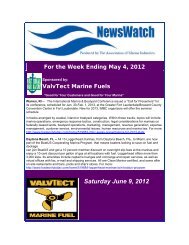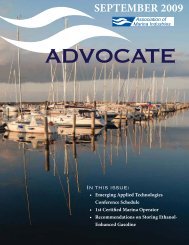Sept12 (2).pdf - Association of Marina Industries
Sept12 (2).pdf - Association of Marina Industries
Sept12 (2).pdf - Association of Marina Industries
Create successful ePaper yourself
Turn your PDF publications into a flip-book with our unique Google optimized e-Paper software.
14Technical Advice Continued from Page 13older boats that may have had some water in the bottom<strong>of</strong> the tank for years. Kelley says that once ethanol is introduced,the water — along with more that may be comingthrough a leaking deck fitting — will be absorbed and caneventually lead to phase separation. This leaves a layer <strong>of</strong>water/ethanol on the bottom <strong>of</strong> the tank. If the fuel pickup— resting at the bottom <strong>of</strong> the tank right where the mixtureis — picks up a slug <strong>of</strong> water, the engine will quit. If thatisn’t bad enough, there’s more: “This water/ethanol mixtureis quite corrosive, too, and aluminum fuel tanks are at risk<strong>of</strong> corroding from the inside if they are in contact with thisstuff,” says Kelley. Preventing water from getting into thetank is much easier than removing it so make sure the fuelfill gasket has a tight fit and keep your tank full, — thislimits the amount <strong>of</strong> water that can get into the tank fromcondensation. If you suspect you may have water in yourtank, contact a company that specializes in cleaning outtanks. Seaworthy has reported on several insurance claimsfor damage and injuries caused by using improper equipment(such as a wet vac) to clean out a tank — leave it tothe pros. Not sure if you have water in your tank? You canbuy a product called Kolor Kut that’s dabbed on the end <strong>of</strong>a stick and lowered into your fuel tank; it changes color oncontact with water. One more thing to mention: Don’t plugthe fuel tank vent in an attempt to keep moisture out. It’sdoubtful much gets in that way and plugging the vent couldlead to pressure in the tank, which could cause a spill.More On Carburetors“Carburetors are dumb,” says Alyanak. “From the factory,they’re calibrated to run on one kind <strong>of</strong> fuel and can’t makeadjustments on their own, like modern electronic fuel injectioncan.” Engines that were built many years ago, beforeethanol, were calibrated to run on straight gas, he says.“Ethanol has extra oxygen in it, which throws <strong>of</strong>f the air/fuel ratio, making the engine run too lean,” he says. Leanengines run hotter and have what are euphemistically called“drivability problems” — hard starting and rough running.It’s possible, he says, to recalibrate a carburetor to tolerateE10; a good mechanic can do it. New carbureted enginescome calibrated for E10.Older aluminum carburetors tend to suffer from the corrosiveeffects <strong>of</strong> ethanol much more than newer ones, whichare made out <strong>of</strong> more resistant alloys. The corrosion shownhere blocked tiny passages and caused hard starting andrough running.Tips For Older Engines:• Fuel-system components on older engines, those builtprior to about 1990, should be inspected before startingthe engine in order to identify any signs <strong>of</strong> leakageor corrosion.• Mercury’s fuel expert Kelley says if you are going torun on E10 for the first time, check for the presence <strong>of</strong>water in your tank, which is common in older boats.Ideally, your tank should be empty <strong>of</strong> all fuel and waterbefore you add E10.• Make sure your fuel-fill gasket doesn’t leak, or rainwaterand spray can get into the tank.• Don’t add a fuel dryer, which is <strong>of</strong>ten ethanol — it willjust compound the problem. Kelley recommends usinga fuel stabilizer instead each time you fill up (also true<strong>of</strong> newer engines). Watch out, he warns: Some octaneboosters contain ethanol as well — read the label beforeyou add any. Incidentally, according to the chemicalengineers, there is no way to recombine separatedwater and E10.***********Charles Fort is associate editor <strong>of</strong> Seaworthy, the BoatU.S.Marine Insurance damage-avoidance publication, which isfree to all BoatU.S. insureds. For an insurance quote, pleasecall 1-800-283-2883 or apply online at BoatUS.com.Technical Advice Continued on Page 15












